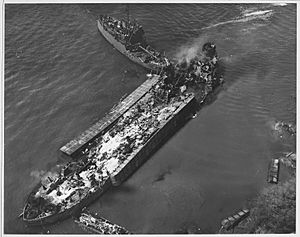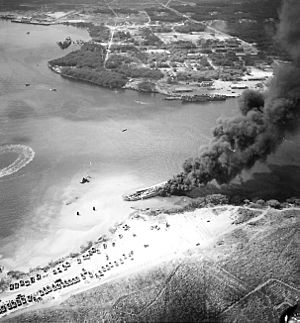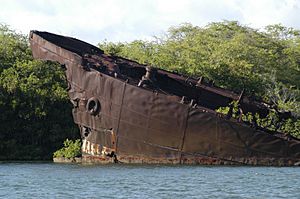West Loch disaster facts for kids
Quick facts for kids West Loch disaster |
|||||||
|---|---|---|---|---|---|---|---|
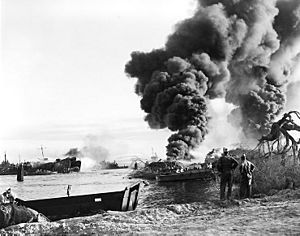 LST-39 and LST-480 still ablaze on 22 May 1944. |
|||||||
|
|||||||
The West Loch Disaster was a terrible ship accident during World War II at the Pearl Harbor U.S. Naval Base in Hawaii. It happened on Sunday, May 21, 1944, just after 3 p.m. The accident started with a big explosion in an area where many Landing Ships, Tank (LSTs) and other amphibious assault ships were gathered. These ships were getting ready for a huge invasion called Operation Forager.
A fire quickly spread among the ships. Over the next 24 hours, six LSTs sank. Sadly, 163 Navy sailors died, and 396 were hurt.
A Navy investigation later tried to find out exactly what caused the disaster. They believed the first explosion happened when a mortar round (a type of explosive shell) on board LST-353 went off. This might have happened because it was dropped, or because gasoline fumes caught fire. This event, along with another accident two months later, led to big changes in how the United States Navy handled weapons.
The sunken ships were quickly removed and dumped into the ocean. Only part of LST-480 was left in West Loch. The news was kept secret, and Navy people were told not to talk about it. The disaster was not made public until 1960, which is why many people don't know about it.
Some people have wondered if the Navy found parts of a Japanese midget submarine while cleaning up the wreckage. This might have been the fifth Japanese midget submarine from the Attack on Pearl Harbor in December 1941.
| Top - 0-9 A B C D E F G H I J K L M N O P Q R S T U V W X Y Z |
What Happened at West Loch
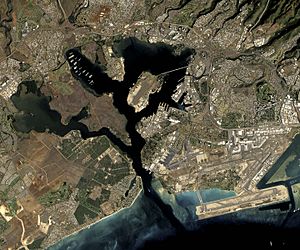
In May 1944, the West Loch area of Pearl Harbor was very busy. It was being used as a place to get ready for a big invasion called Operation Forager. Twenty-nine Landing Ships, Tank (LSTs) were tied up close together at six piers.
Many of these LSTs were full of weapons, fuel, vehicles, equipment, and other supplies. These were for the 2nd and 4th Marine Divisions, who were going to invade the Mariana Islands in mid-June. To help unload quickly, special fuel was stored in barrels on the ships' decks.
In the weeks before the accident, the ships and their crews were training for the invasion. Each LST had about 120 Navy sailors or Coast Guardsmen. They also had about 200 Marines who loaded, drove, and fixed things. The Navy had grown very fast, so many of the crews were new and didn't have much experience. On May 21, many ships had only half their crew on board. Most officers and sailors had been given time off on land after a week of hard training.
The Explosion and Fire
At 3:08 PM, a ship called LST-353 exploded. It was tied up at Pier 8. A huge fireball shot into the sky. The loud noise was heard far away at Pearl Harbor Headquarters.
More explosions followed, getting stronger each time. People worried it was a Japanese attack or even an earthquake. Fire and falling pieces from the first explosion landed on other LSTs. These ships had fuel and weapons on their decks, causing a chain reaction of explosions.
Within minutes, 200 men were blown into the water. Eleven wooden buildings on the shore were destroyed, and vehicles were flipped over. In total, 20 buildings were damaged.
At first, the crews tried to fight the fires, but the heat was too much. Many LSTs tied together at Pier 8 began to sink. Within an hour, Admiral Richmond K. Turner was helping direct the firefighting from a small boat.
Some LSTs managed to move to safety by themselves or with help from tugboats. But others were left behind and drifted, spreading fires, before sinking. Leaking oil on the water also spread fires to Piers 7 and 9, even though they were not hit by the first explosions.
Eventually, tugboats and special foam-carrying ships from Pearl Harbor arrived to fight the spreading fires. One ship managed to push a drifting LST away from an ammunition ship. This ammunition ship was docked across the loch.
The last big explosion happened at 10:30 PM. Several LSTs continued to burn for 24 hours. Many harbor tugs and other small boats were damaged while trying to put out the fires.
People Affected
The first official report said 27 people died and 100 were missing. Most sources now say that 163 men died, and 396 were hurt. However, one magazine in 2005 claimed that 392 people died in total. It said 163 were sailors, and the other 229 were Marines.
A researcher named Ray Emory also thinks the official death toll is wrong. He believes 132 men died at West Loch.
The Investigation
A Navy investigation started the very next day at Pearl Harbor. It was led by Rear Admiral John F. Shafroth Jr.. An early idea that a Japanese submarine caused the accident was quickly dismissed. The West Loch was too shallow, and there were anti-submarine nets.
The officer in charge of LST-353 said that just before the explosion, Army workers were unloading mortar ammunition. They were taking it from a smaller boat on his ship's deck. This was being done because tests showed that these mortars could not be fired well from the smaller boats. The investigation learned that the unit told to unload the mortar rounds had not been trained for this job. Also, 80 barrels of fuel were stacked only 15 feet from where the ammunition was being unloaded.
After hearing from witnesses, the Navy investigation decided that a mortar round exploded on LST-353. This caused a chain reaction. However, they could not figure out exactly why the mortar exploded. Everyone closest to the explosion had died.
The two most likely reasons were:
- A mortar round was accidentally dropped while being unloaded from the smaller boat on LST-353.
- Gasoline fumes from the fuel barrels on LST-353's deck caught fire. This could have been from a cigarette (even though smoking was banned) or from welding, which was also happening on LST-353 that day.
The investigation also heard that the new crews might have made the disaster worse. A Navy officer criticized many LST crews for leaving their ships too early. He said they should have fought the fires or tried to move their ships to safety. However, he praised the crew of LST-274, which was badly damaged but saved.
Some crews and captains were questioned about their actions. But the very dangerous conditions were seen as a reason for their choices. In the end, no one was punished. Loading fuel and weapons on ships tied closely together was seen as necessary during wartime. Admiral Chester W. Nimitz disagreed with a suggestion to avoid tying ships together in the future, saying it was not practical.
Keeping it Secret
The U.S. military ordered that no news about the accident be shared. The official investigation was marked "Top Secret." Survivors and witnesses were not allowed to mention the incident in letters home.
Four days after the accident, the authorities released a short statement. It only said that an explosion caused "some loss of life, a number of injuries and resulted in the destruction of several small vessels." A more complete story was only released to the news after Operation Forager was over. The entire incident was not made public until 1960.
Because of all this secrecy, many people still don't know much about Pearl Harbor's "second disaster." A survivor named William L.C. Johnson wrote a book about it. He said the Navy didn't give a full account until 1964. He also believed the accident was caused by careless smoking.
Impact on the Invasion Plan
Six LSTs sank: LST-39, LST-43, LST-69, LST-179, LST-353, and LST-480. Two of these already had smaller, fully loaded Landing craft tanks (LCTs) tied to their decks. Several other LSTs were damaged or ran aground. Four ships could not be fixed in time for the invasion. Seventeen tracked landing vehicles and eight 155mm guns were destroyed.
Other sources say that nine LSTs were destroyed in total. However, with help from other ships and quick repairs, the big invasion (Operation Forager) was only delayed by one day. It started mostly as planned three weeks later.
Medal of Honor
A Navy diver named Francis P. Hammerberg received the Medal of Honor after he died. He was given this award on February 17, 1945, for being a hero during the cleanup of a sunken LST in West Loch. He died when a tunnel he was digging under one of the sunken ships collapsed. He was the only person in World War II, and the last person ever, to receive the Medal of Honor for an action that was not in combat. Before World War II, the Navy often gave out this medal for non-combat bravery.
Memorials
In the weeks after the disaster, all the wreckage was removed. The only exception was LST-480. Its rusting front part was left where it had been pushed onto the shore during the accident.
In April 1995, the first memorial for the disaster was put up. It was a large plaque on the shore of the loch. Because Congress asked for it, the gravestones of unknown victims in the National Memorial Cemetery of the Pacific were changed. In the 2000s, they were updated from just saying "unknown" to "Unknown, West Loch Disaster, May 21, 1944." The Navy remembered the 65th anniversary of the disaster on May 21, 2009.
What We Learned
Because of this accident and another one two months later, the Navy completely changed how it handled weapons. They made sure that people handling weapons were fully trained. They also made sure that weapons were designed to be safer. Most importantly, they decided that ships should no longer be tied closely together when ammunition was being loaded or moved.
It's also possible that the cleanup after the disaster accidentally made it harder to find a "fifth midget submarine." This submarine was thought to be involved in the 1941 attack on Pearl Harbor. After parts of a midget submarine were found three miles south of Pearl Harbor, some researchers thought it was the missing one. They believed it had entered the harbor, attacked ships, then escaped into West Loch. There, its two-person crew might have sunk it on purpose. If so, it would have been removed during the cleanup of the LSTs and then dumped into the ocean.
|



